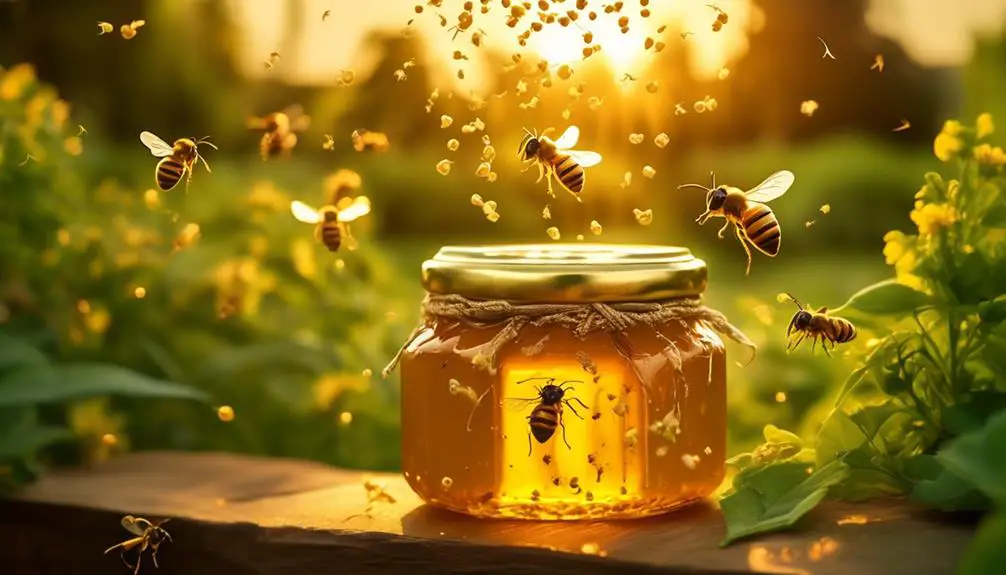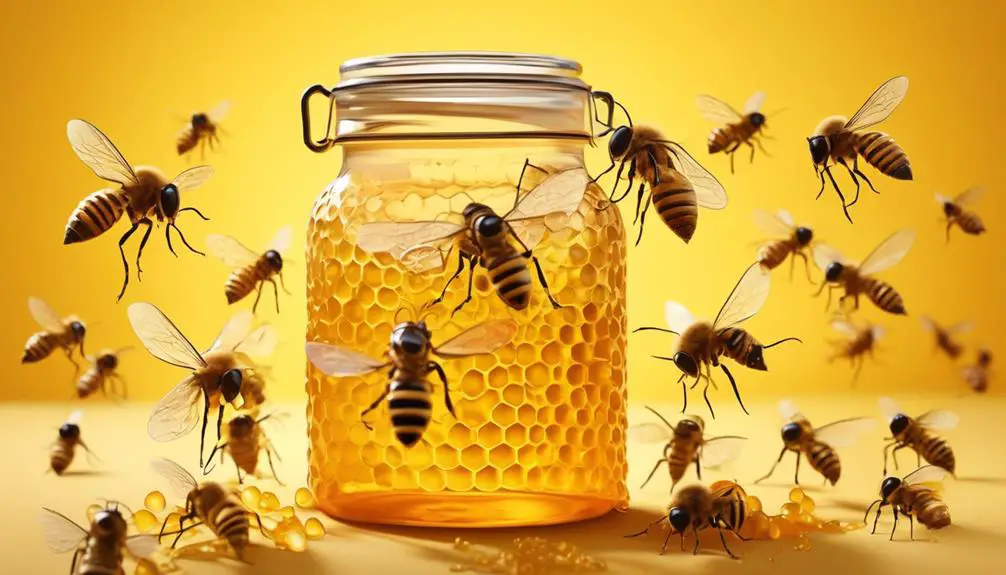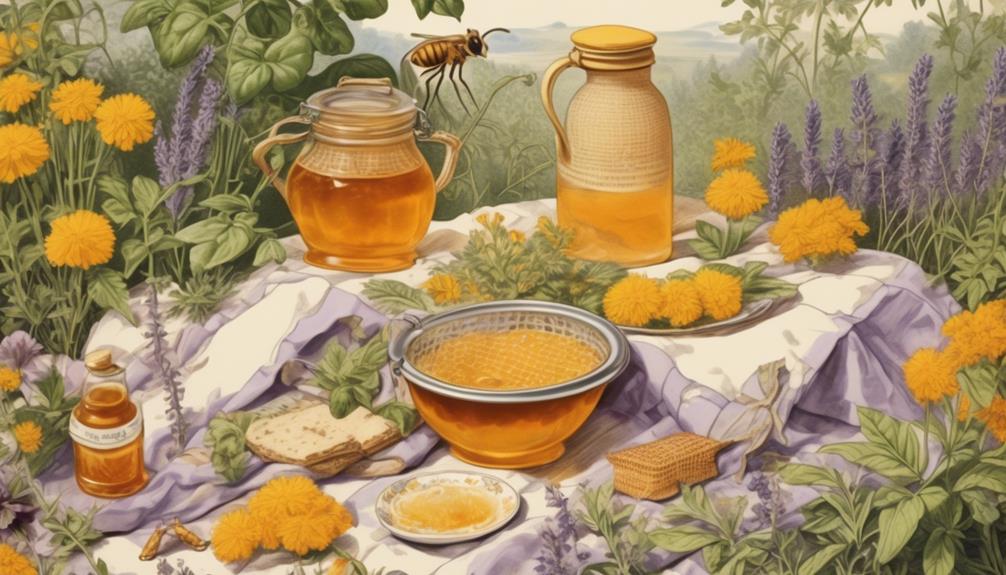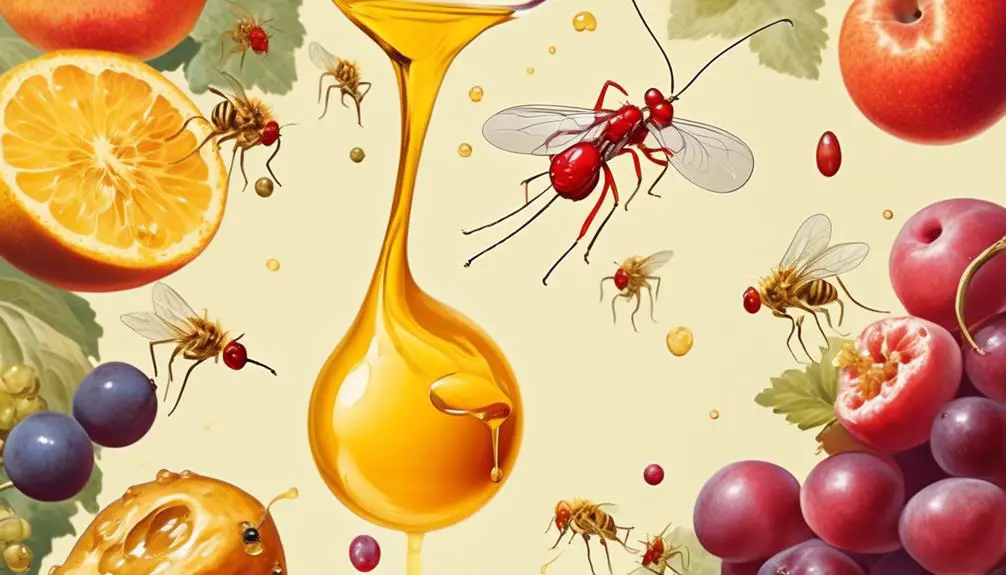Learn whether gnats are indeed attracted to honey and how this curious relationship can impact your gnat prevention efforts.

Are Gnats Attracted to Honey?
In the world of tiny buzzing nuisances, gnats and honey seem as disparate as night and day. You've probably seen gnats flitting around your houseplants or annoyingly invading your summer barbecue, but have you ever noticed them flocking to the sweet stickiness of honey?
It's a question that might not have crossed your mind until now. While it's common knowledge that some insects, like bees, have an undeniable attraction to honey, the relationship between gnats and this sugary substance isn't as straightforward.
Let's set out on this intriguing journey to unravel the mystery of whether these pesky insects are indeed lured by honey, and what this could mean for your gnat prevention strategies.
Key Takeaways
- Gnats are attracted to honey due to its sugars, organic compounds, and scent.
- Honey serves as a breeding ground for gnat larvae and traps gnats due to its sticky nature.
- Gnat attraction to honey is influenced by a combination of chemical, nutritional, and environmental factors.
- Implementing prevention strategies such as storing honey in sealed containers and using gnat-repellant plants can help manage gnat infestations effectively.
Understanding Gnat Behavior

To fully grasp why gnats may be attracted to honey, it's essential to first understand their behavioral patterns and preferences. Gnats, like many insects, are driven by their senses, primarily olfaction. They're attracted to strong, sweet scents. Honey, with its potent aroma and high sugar content, easily draws them in.
Gnats are also opportunistic feeders. They consume a variety of food sources, often those high in sugar or protein. The sugary nectar of honey is, therefore, a prime target for these tiny pests. Moreover, gnats are drawn to moist environments. Honey, especially when exposed to air, can attract moisture, creating a perfect habitat for gnats.
Lastly, gnats exhibit a behavior known as 'positive phototaxis', meaning they're drawn to light. The sheen of honey can reflect light, potentially attracting gnats even more. So, it's not just the sweetness of honey that may attract gnats, but also its physical properties.
Understanding these aspects of gnat behavior can help you understand why honey might be an irresistible attraction to them. It's not a simple case of sweet tooth, but a complex interplay of sensory attraction, feeding habits, and environmental preferences.
Honey: A Gnat Magnet?

Given these behavioral traits of gnats, it's clear why you might find them swarming around your honey jar, making it seem like a veritable gnat magnet. Honey, rich in sugars and organic compounds, is a prime attractant for these tiny insects. They're drawn to its sweet aroma and sticky consistency, which provide ample feeding opportunities.
In addition to being a food source, honey also serves as a hospitable breeding ground for gnats. The moisture content and organic material present in honey create a conducive environment for gnat larvae to thrive. When you pair these factors with its sticky nature, which can trap gnats, effectively immobilizing them, it's no wonder your honey jar seems to be a magnet for these pests.
In the presence of honey, gnats display an increased level of activity and attraction. This is due to the olfactory cues it emits, which gnats perceive through their well-developed antennae. Hence, the presence of honey can significantly augment the concentration of gnats in your surroundings. So, if you're wondering why gnats seem to be particularly drawn to your honey jar, now you have a scientifically sound explanation.
Gnat Attraction: Decoding the Science

Delving into the science behind gnat attraction, it's your honey's complex blend of sugars and organic compounds that acts like a beacon for these tiny pests. This isn't just a simple case of gnats having a sweet tooth; it's a sophisticated chemical interaction.
Gnats, like many insects, possess highly developed chemosensory systems. They can detect and are drawn to the specific volatile compounds present in honey. One critical compound in this mix is ethyl butyrate, a fruity-smelling compound found in many ripe fruits and, of course, honey. When a gnat's antennae pick up on this scent, it's akin to ringing the dinner bell.
Moreover, the sugars in honey – primarily fructose and glucose – provide a high-energy food source for gnats. These sugars are easily metabolized by gnats, providing the energy they need for their rapid life cycle.
Lastly, water activity in honey also plays a role. Honey, while low in water content, has enough moisture for gnats. They're attracted to damp environments, and honey's hygroscopic nature, its ability to attract and hold water molecules, certainly appeals to them. So, it's not just sweetness luring them in, but a complex interplay of chemical, nutritional, and environmental factors.
Prevention Tips: Keeping Gnats Away

Armed with an understanding of what attracts gnats to honey, you're better equipped to keep these pesky insects at bay. Your first line of defense involves minimizing sources of attraction. Since gnats are drawn to sweet smells, ensure that you store honey and other sugary substances in sealed containers.
Next, consider using gnat-repellant plants like marigolds or citronella, which emit a scent that gnats find undesirable. These can be placed near doors or windows to discourage gnats from entering.
For indoor prevention, maintain a clean environment. Gnats thrive in moist and dirty areas, so regular cleaning helps reduce their breeding grounds. Pay special attention to your kitchen and bathroom, removing food particles, standing water, and damp areas.
Another effective prevention method involves using vinegar traps. Fill a jar halfway with apple cider vinegar, add a few drops of dish soap, and cover it with a perforated lid. The vinegar's scent lures the gnats, while the soap traps them.
Exploring Other Gnat Attractants

While keeping honey safely stored away can help deter gnats, it's also important to consider other elements in your home or garden that could potentially draw them in. Among these, the most common attractants are rotting fruits and vegetables, especially bananas and tomatoes. These provide a rich source of food and a breeding ground for these pesky insects.
Besides food, gnats are also attracted to moisture. Overwatered plants, leaky pipes, or damp basements can become a magnet for gnats. Therefore, maintaining a dry environment is crucial to keep gnats at bay.
Similarly, gnats are drawn to light. They're often seen swarming around lamps or windows. Dimming your lights or using yellow bulbs can help reduce their attraction.
Lastly, let's not forget about compost piles. They're a gnat's paradise, providing them with both food and a perfect breeding site. If you compost, consider using a tightly sealed bin and turning it regularly to discourage gnats.
Conclusion
In conclusion, you've learned that gnats are indeed attracted to honey due to its sweet scent and high sugar content. However, remember it's not only honey that lures these pests in. Other sweet or fermented substances can also draw them.
Understanding this, it's crucial to practice good housekeeping and proper food storage to keep gnats at bay. Stay vigilant, and you'll significantly reduce the likelihood of a gnat infestation in your home.



